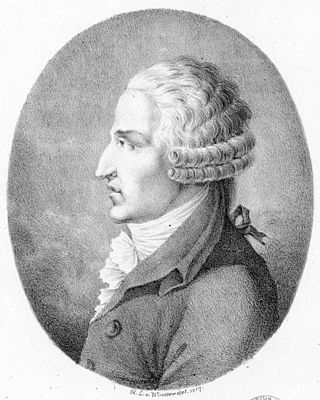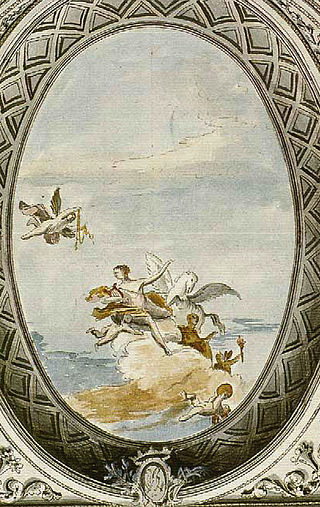
Lo sposo deluso, ossia La rivalità di tre donne per un solo amante is a two-act opera buffa, K. 430, composed by Wolfgang Amadeus Mozart between 1783 and 1784. However, the opera was never completed and only a 20-minute fragment from act 1 exists.

Giuseppe Gazzaniga was a member of the Neapolitan school of opera composers. He composed fifty-one operas and is considered to be one of the last Italian opera buffa composers.
"Vorrei spiegarvi, oh Dio!" is a soprano aria by Wolfgang Amadeus Mozart.

Pasquale Anfossi was an Italian opera composer. Born in Taggia, Liguria, he studied with Niccolò Piccinni and Antonio Sacchini, and worked mainly in London, Venice and Rome.
Joachim Albertini or Gioacchino Albertini was an Italian-born composer, who spent most of his life in Poland. His opera Don Juan albo Ukarany libertyn was performed in the 1780s with both Italian and Polish libretti.
Vincenzo Fabrizi was an Italian composer of opera buffa.
Giovanni Bertati was an Italian librettist.
A catalogue aria is a genre of opera aria in which the singer recounts a list of information that was popular in Italian comic opera in the latter half of the eighteenth and early nineteenth centuries.

Le donne rivali is an intermezzo in two acts by composer Domenico Cimarosa with an Italian libretto by a now unknown poet. It is speculated that Giuseppe Petrosellini may have been the author of the libretto. The opera premiered at the Teatro Valle in Rome during Carnival in 1780. The original choreography was created by Alberto Cavos, the original costumes by Antonio Dian, and the original scenery by Domenico Fossati. In accordance with Papal law on theatre in Rome, the premiere cast was all-male.

The Teatro San Moisè was a theatre and opera house in Venice, active from 1620 to 1818. It was in a prominent location near the Palazzo Giustinian and the church of San Moisè at the entrance to the Grand Canal.
La vera costanza, is an operatic dramma giocoso in three acts by Pasquale Anfossi. The comédie larmoyante-influenced Italian libretto was by Francesco Puttini. The opera preceded Joseph Haydn's better known setting of the same libretto by three years.
Antonio Palomba (20 December 1705 – 1769) was an Italian opera librettist, poet, harpsichordist, and music educator. He also worked as a notary. Born in Naples, he became a teacher of the harpsichord at the Teatro della Pace in 1749. Most of his more than 50 opera libretti were comedic works written for composers of the Neapolitan school. He also wrote some works for performance in Florence, Bologna and abroad. He died in Naples in 1769; one of the victims of a fever epidemic in the city. Many of his libretti were set more than once to music, and composers continued to use his libretti up into the 1830s.
Ferdinando Orlandi, also referred to as Orland and Orlando. Little is known of his early life and his year of birth is also cited as 1777. He was an Italian musician and teacher of singing who composed cantatas and sacred music, but was particularly known for his operas, not all of which have survived. He was born and died in Parma.

Sì is an operetta in three acts composed by Pietro Mascagni to a libretto by Carlo Lombardo with verses by Arturo Franci. The libretto is based on Lombardo's operetta La duchessa del Bal Tabarin and Felix Dörmann's libretto for Majestät Mimi set by Bruno Granichstaedten in 1911. Mascagni's only venture into operetta, it premiered on 13 December 1919 at the Teatro Quirino in Rome. The operetta takes its name from its central character, Sì, an actress at the Folies Bergère, so called because she could never say no.

L'avaro, is an opera in three acts composed by Pasquale Anfossi. The libretto by Giovanni Bertati is based on Molière's 17th-century comedy The Miser. Considered one of Anfossi's best operas, it premiered at the Teatro San Moisè in Venice in the autumn season of 1775 and was subsequently performed throughout Italy and in other European cities.

The Teatro delle Dame, also known as the Teatro Alibert, was a theatre in Rome built in 1718 and located on what is now the corner of Via D'Alibert and Via Margutta. In the course of its history it underwent a series of reconstructions and renovations until it was definitively destroyed by a fire in 1863. In their 18th-century heyday, the Teatro delle Dame and its rival, the Teatro Capranica, were the leading opera houses in Rome and saw many world premieres performed by some of the most prominent singers of the time.
Giuseppe Petrosellini was an Italian poet and prolific librettist working primarily in the dramma giocoso and opera buffa genres.
Caterino Tommaso Mazzolà was an Italian poet and librettist. Born into a wealthy family from the islands of Murano, he and his family moved to Venice around 1767, but after a few years he moved to Treviso. He married in 1780 and having already met Giacomo Casanova and Lorenzo Da Ponte, started work as a librettist.

Il ritorno di Don Calandrino, also known as Armidoro e Laurina, is an intermezzo in two acts by Domenico Cimarosa to an Italian libretto presumably written by Giuseppe Petrosellini.
La finta giardiniera is a 1774 opera by Pasquale Anfossi to a libretto by Giuseppe Petrosellini, not Calzabigi, premiered at the Teatro delle Dame, Rome, for Carnival 1774. The opera by Mozart to the same libretto followed in Munich, 13 January 1775.








